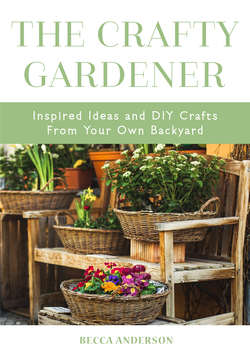Читать книгу The Crafty Gardener - Becca Anderson - Страница 20
На сайте Литреса книга снята с продажи.
ОглавлениеMintcense
One thing you can do, if you decide to grow a variety of mint, is to make mint potpourri. Originally made in colonial times, when it was believed to “clear the head,” it is an excellent natural room freshener.
•¼ cup orris root
•1 tablespoon oil of lavender or pennyroyal
•2 cups dried orange mint
•2 cups dried spearmint
•2 cups dried peppermint
•1 cup dried thyme
•1 cup dried rosemary
Combine the orris root and essential oil. Add the rest of the ingredients and combine gently, taking care not to crush the leaves too much. Store it in a covered jar. To use, shake and open.
Mother Nature’s Moth Repellents
If you want to avoid using mothballs for your woolens this coming summer, try dried branches of rue, tansy, mint, lavender, rosemary, pennyroyal, and wormwood, either by themselves or in combination. Tie them together and, to keep them from flaking onto your closet floor, wrap them lightly in cheesecloth and hang upside down from a ribbon in your closet.
A house, though otherwise beautiful, yet if it hath no garden is more like a prison than a house.
—William Coles
Go Organic: Easter Eggs with Natural Dyes
Want to do something a little more sophisticated this Easter? You and your older kids might enjoy the subtle beauty of these natural wonders. But beware—these are for decoration only. Do not eat.
•1 red cabbage
•2 very large brown-skinned onions (a.k.a. yellow onions)
•1 dozen eggs
•36 rubber bands
•2 dozen small fern fronds and/or fresh and dried flower blossoms
•1 tablespoon powdered alum
•1 roll cheesecloth
Without cutting the cabbage in two, cut the central core out and separate the leaves so that each leaf is as large as possible. Cut the two ends of the onions and peel the skin off, again keeping each piece of skin as large as possible.
Place a fern or flower against an egg, one on either side, and wrap it completely with a red cabbage leaf, using two rubber bands to keep it on. Repeat for five more eggs. Use the onion skins and remaining flowers and ferns for the other six eggs, again using two rubber bands to affix. Cut 12 pieces of cheesecloth, big enough to wrap completely around each egg, and secure with two more rubber bands.
Place the cabbage eggs in one pot and the onion eggs in another. Add water and 1 ½ teaspoon alum to each pot. Bring to a boil, reduce heat, and simmer for 15 minutes. Remove from heat and allow eggs to cool in water. Unwrap and enjoy your designs. Makes a dozen.
The hours when the mind is absorbed by beauty are the only hours when we really live.
—Richard Jefferies
Eggshell Planters
Ordinary eggshells make beautiful planters for small herbs or grasses. Break raw eggs, leaving shell at least one-half intact. Empty the contents into a separate bowl, and rinse the shell thoroughly. Place already-sprouting plants (mint, lavender, chives, or sage work well, as will wheatgrass, alfalfa, or small ferns) in the shells, anchored with a bit of topsoil. Cushion an assortment of shells and plants in moss, and place in a beribboned basket or pot. Experiment using dyed or decorated eggshells.
Wonderful Water Gardens
It seems that garden ponds are in these days—the garden catalogs are full of such kits. I even have a friend who had an entire stream put into his property. I must say, when I saw it, I lusted after it myself until I realized the trouble and expense it would involve. One day I read an article by the horticulturalist for the Denver Botanic Gardens in which he sang the praises of tiny water gardens. They are easy to create, hard to goof on (you can always rearrange) and—as long you have a location that gets six hours of sun—the plants are hard to kill. So I decided to give it a try. Mine is made out of one of those nine-inch black plastic containers that look like they’re cast iron. All it has is tiny cattail, a spider lily, and a clump of cranberry taro. It sits in the middle of my vegetable garden, and I smile every time I see it.
